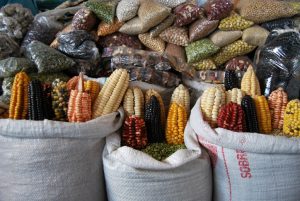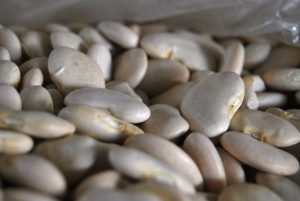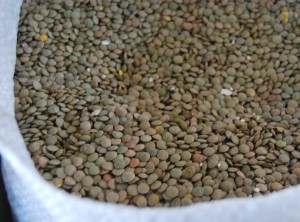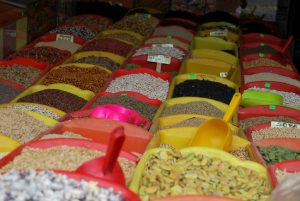Beans Make Hardy Meals in Cuzco

Cuzco’s people work at a whole range of jobs. Some of them are more delicate office-based work, and some require lots of strength and energy. One example of this last group are the albañiles, people who work laying brick and doing construction. For lunch, they opt to eat legumes, menestras as we call them. Besides enjoying something pleasing, they fill themselves with the energy to allow them to work hard the rest of the day.
Menestras include various varieties of beans, as well as lentils, panamitos, and lima beans that we call pallares. Though we enjoy them in different preparations and find them delicious, all these beans are raised in the lowlands, especially on the coast. Our vendors, caseras, have them brought from there, and distribute them in our markets and stores.
In Cuzco we find various kinds of beans, including the frijol san jacinto, the sol de oro, the canario, the morado, the castilla, and the bayo. Each of these has a different color, texture, and flavor.
We cook these beans in different dishes according to their qualities, which of course people debate. For example, the frijol san jacinto is the one we most use in Cuzco. The dishes prepared from it include the frijol with lamb seco and white rice. With it people also make beans and pork strips (lonjas de chancho) and rice as well as fish, beans, and rice.
While these dishes can be made with any of our beans except the castilla which is most used in cuisine from the jungle.

Only our menestras allow for such a variety of dishes.

While we do not consider it a bean, although the botanists do, the panamito is prepared in a similar fashion to our beans. It is white and people love to prepare it to accompany a grilled or fried beef steak and accompaniment of salad of onion and tomato. Together the beans, meat, and salad make this dish absolutely wonderful for lunch time.
Lentils are another of our menestras. They are similar to the panamito in our sense, just like the beans. The preparation is the same. They are often served with ground beef and white rice, as well as with pork strips and white rice. Each dish has a different flavor and is delicious.
The pallar, or large lima bean, is also a relative of beans, lentils, and panamitos. It is made in the same way, although it is often accompanied with a delicious chicken stew and white rice. Even though it is white, this bean reminds us much of the green haba or fava bean.
Many of these dishes can be found in the markets where they are sold for S/ 7 (about $ 2.80 US). They are also sold in restaurants as part of the menu del día which costs S/ 3.5 (about $1.40 US). Generally, though, the people of Cusco prepare these dishes in their homes for a Sunday in Family or for a Lentil Monday.
These legumes can be found easily in the markets of the city at an economical price. They are sold by the kilo. The kilo of beans is S/ 7, panamito S/ 6, lentils S/ 4.5, and Lima beans S/ 6. All of these dishes are straightforward and easy to prepare.

Finally, the caseras (vendors) recommend that any of these preparation be consumed only for lunch. At night they can be too heavy for your stomach and result in painful discomfort.
Frijol con Seco de Cordero (Beans with Stewed Lamb)
Ingredients
_ 1/2 kilo beans
_ 1/2 kilo lamb or mutton
_ 1/2 kilo of cholo or gallito rice
_ 2 onions
_ 1 clove garlic
_ ground cumin
_ ground pepper
_ 0.30 cents worth of cilantro
_ oil
_ ajinomoto (monosodium glutamate)
_ sibarita (a Peruvian condiment mix)
Preparation
First clean the beans of any stones. Wash them in abundant water and place them to soak for a day before cooking. Then bring the beans to a boil in an express pot (pressure cooker) for an hour and a half. In another pot make your dressing by sauteing finely minced onion and garlic along with cumin and pepper to taste. Once the dressing is well cooked add the sibarita to give color to give it color. Then mix the dressing with the beans and reheat. Add salt to taste and mix well. The beans are ready.
For the lamb seco make a dressing with the same ingredients, except for the sibarita. Once it is ready add to it the chunks of lamb and let cook for some twenty minutes. While it cooks run the cilantro through a blender and then add to the meat mixture. Cook for thirty minutes more. The lamb is now ready.
Serve a mound of white rice on each plate surrounded by beans. Add the meat stew on top. This is a dish that is enjoyed on special occasions or on Sundays.

Translator’s Note
Some issues arose in the translation that require clarification. The article is written from conversations with the market vendors, the famous caseras of Cuzco. As a result, it is not a scientific discussion of the kinds and types of beans and the relationship between beans and similar seeds. It is the popular classification and understanding as mobilized in the market.
For example, the panamito is classified technically as a phaseolus vulgaris, i.e. bean, but in the market is is separated from the classification of beans. On the other hand the black-eyed pea, or frijol castilla, is a different species entirely, vigna unguiculata, though in the market it is classified as a bean.
The frijol morado seems to be a kidney bean. The canario is widely available in Latin Markets.
While the caseras said all the beans are brought from the coast, it turns out Cuzco is a producer and exporter of beans.
The white rice called for as a side to the beans is what in Peru is called arroz graneado. This is rice that has been toasted lightly, whether dry or in oil, before being boiled. Granear is the process of toasting.
Sibarita is a well-known Peruvian seasoning combining turmeric with different condiments. You might find this in Peruvian groceries abroad or on line. However if you do not find it, you can substitute with powdered turmeric.
The ajinomoto is a well known Japanese seasoning widely sold in Peru and widely available abroad. It is basically monosodium glutamate. You should be able to find it in Asian or perhaps Latin markets or you can just use monosodium glutamate, or leave it out if that is your preference.





